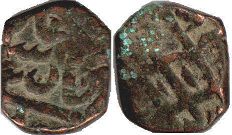Coins of Mughal Empire - catalog with values
Mughal Empire
Rupee
Muhammad Shah (1717-1748)

1 dam 17 (24-33)
copper
Coin value ~ 8-12 USD
Costs of Mughal Empire coins in this catalog approximate and indicated specifically for the coin shown in the picture.
I do not buy or sell coins - this is just a catalog.

